Even when the rest of the garden is still in hibernation, the winter snowball enchants with a full, pink bloom. As a winter bloomer, it is also interesting for bees.
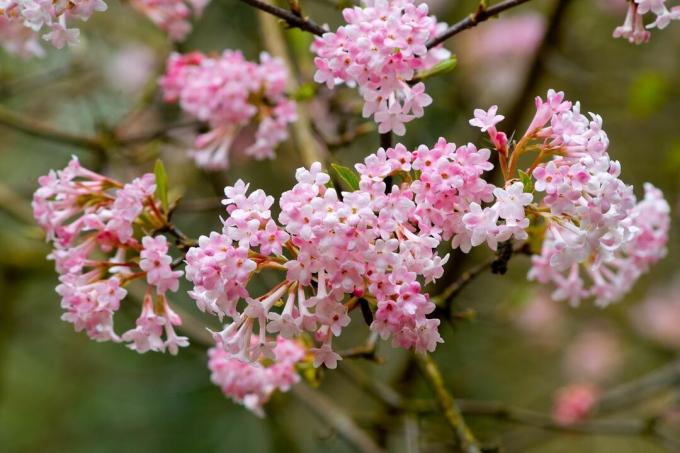
The winter snowball is an easy-care and magnificent ornamental shrub that is suitable for any garden or as a container plant. We introduce you to this winter bloomer and give tips on planting and caring for it.
contents
- Winter snowball: flowering time and properties
- The most beautiful winter snowball varieties
- Planting winter snowballs: location and procedure
- Caring for the winter snowball: pruning, fertilizing and more.
- Multiply winter snowball
- Properly hibernate
- Is the winter snowball poisonous?
Winter snowball: flowering time and properties
The Winter Snowball (Viburnum x bodnantense) or also called Bodnant snowball, belongs to the family of the musk herb plants (Adoxaceae). The name can be traced back to the Bodnant Garden breeding site in North Wales. The winter snowball is a hybrid of the scented snowball (
Viburnum farreri) and the large-flowered snowball (Viburnum grandiflorum).The winter snowball is an ornamental shrub and can be found in many parks and gardens. It grows rather slowly, taking about 10 to 20 years to reach its maximum size. In old age it develops a dense bushy display up to 3 meters wide, so it should be planted with enough space to the sides. In summer, the winter snowball is characterized by a deep green foliage. The leaves sit on red stalks and can have a wide variety of shapes. If you rub a leaf between your fingers, you can smell a distinctive, sometimes unpleasant smell. In autumn, the foliage turns picturesque red and violet tones and is in no way inferior to the beauty of the pink blossoms.

The magnificent pink-white flowers can be seen from January to April - in mild winters even as early as November. The unusual flowering period was created by crossing the scented snowball, which blooms in November, and the large-flowered viburnum, which blooms in spring. At the beginning of flowering, the buds are visible in a rich pink, only when the buds open do the flowers become lighter, up to a delicate pale pink. In addition to the visual splendor, the flowers exude a pleasant scent that smells of vanilla or cloves, depending on the variety.
What does the winter snowball look like in summer? In summer, the heyday of the winter snowball is already over. He then presents his small round fruits. They are initially red and when ripe they are dark blue and lightly frosted.
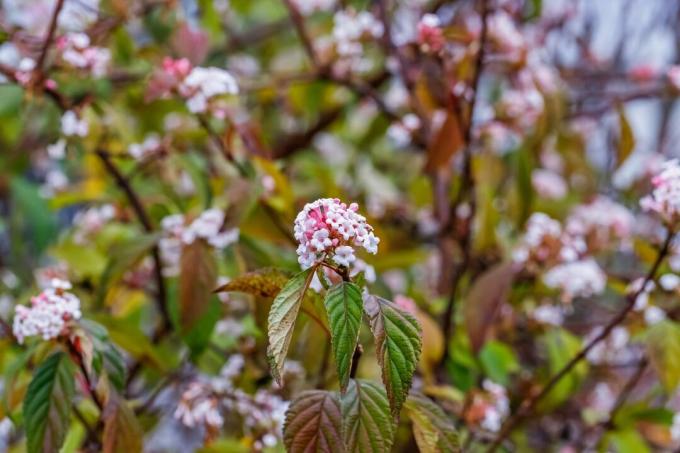
The most beautiful winter snowball varieties
In addition to the original species, there are also some winter snowball varieties that differ mainly in terms of flower color and flowering time. We present some particularly beautiful varieties.
Winter Snowball ‘Dawn’: the sort viburnum x bodnantense 'Dawn' bears light, almost whitish pink flowers and blooms from November to mid-April. With its strong scent, this winter snowball attracts many insects.
Winter snowball ‘Deben’: The flowering period of the 'Deben' variety is somewhat shorter and is between February and April. The flowers are light pink in color.
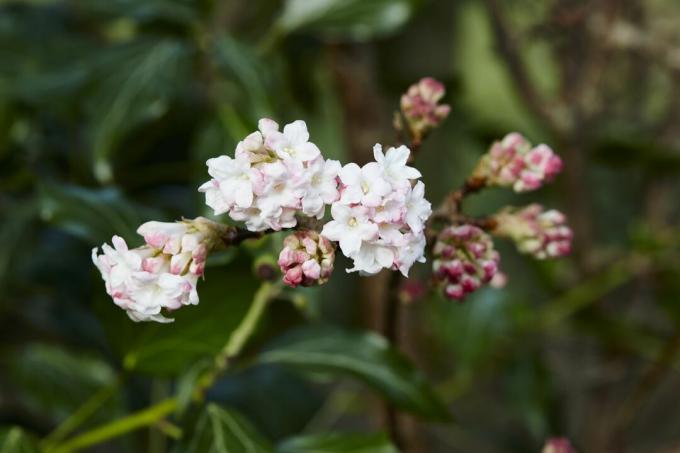
Winter Snowball ‘Charles Lamont’: From January to April shows viburnum x bodnantense 'Charles Lamont' its pretty pink flowers. It's about as wide as it is tall.

Planting winter snowballs: location and procedure
The winter snowball likes a spot in the sun, or a sunny spot. A certain amount of sunlight and warmth are essential for the gorgeous blooms. The demands on the floor are not very special. Well-drained, nutrient-rich, fresh and slightly acidic soil is recommended. If the soil doesn't fit perfectly, the winter snowball forgives these circumstances, but it may not develop as splendidly. If the soil is very dry, the winter snowball should be in partial shade. If you are unsure whether the soil conditions are right, you can use our planting hole Plantura organic universal soil prepare to support the winter snowball. With its slightly acidic pH value, it is in the ideal range for winter snowballs and can store water well without getting wet. The planting hole should be 1.5 times the diameter of the root ball.
Tip: It is best to plant the winter snowball by the wayside or in a place where you spend a lot of time. So you can enjoy the fragrance extensively. It is not for nothing that the shrub is also called "fragrant winter snowball".
To plant the winter snowball, it is best to choose spring or autumn. When planting, care should be taken to ensure that there is sufficient space, as the winter snowball grows very wide and also forms runners to a small extent. A distance of about 1-2 meters is recommended here. Should it be necessary to change location, you should do so within the first 5 years. This allows the winter snowball to survive transplanting better. The best time to do this is immediately after flowering.
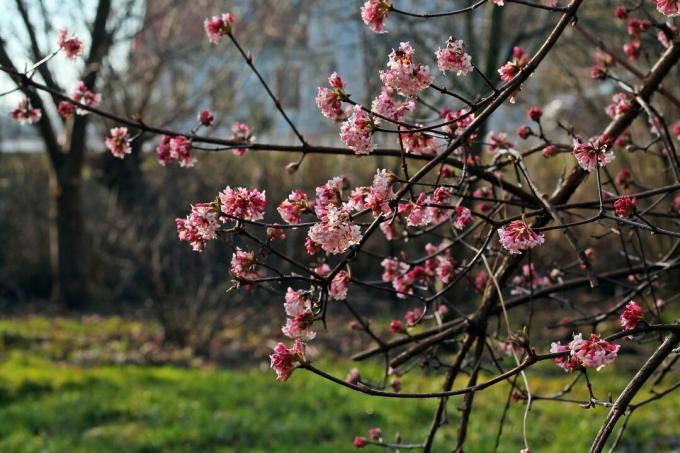
Planting winter snowballs in pots
The winter snowball can also be kept in large tubs. This cultivation is not optimal, but with the right care it can produce a magnificent ornamental shrub. The planter should have good drainage to prevent waterlogging. A layer of potsherds, expanded clay or pebbles can be placed on the bottom of the pot. Ours is also suitable here Plantura organic universal soil as a substrate. To further improve permeability, 30% expanded clay can be mixed in. To reduce water evaporation, the viburnum's root area should be covered with mulch.
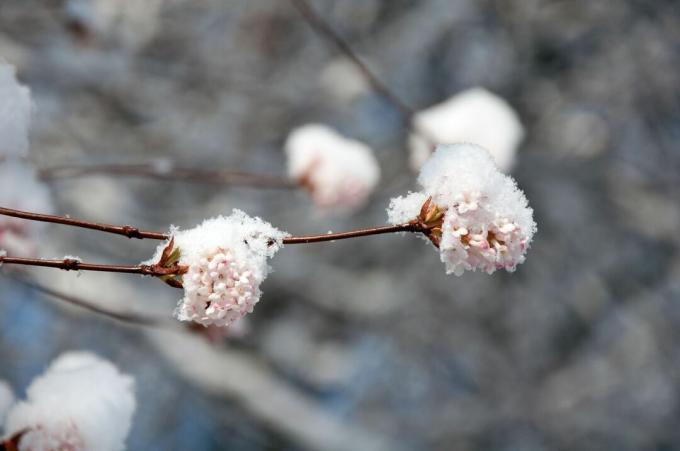
Tip: If you want to save space and still enjoy the full bloom, you can grow your winter snowball as a standard. This is how the flowers really come into their own on top of the slender trunk in the bed or on the balcony and save space. Regular cutting is particularly important in order to keep the shape permanently.
Caring for the winter snowball: pruning, fertilizing and more.
The winter snowball is a very easy-care tree. In the warm summer months it should be watered outdoors if the drought persists. Regular fertilization of the winter snowball is not necessary. If the location is rather nutrient-poor, it makes sense to use compost or organic fertilizer in spring. If the winter snowball is kept in a pot, it must be supplied with long-term fertilizer once a year, as the nutrient supply in the pot is limited. For example, our is suitable for this Plantura organic universal fertilizer, which supplies the winter snowball with all the important nutrients over a period of several months. It is completely harmless to soil animals and can be used both in beds and in pots.
The lush and bushy habit can be shaped by pruning the winter snowball, preferably right after flowering. Shoots that are too long can be shortened above an outward-facing leaf node. Since the winter snowball tolerates pruning well, it can also be thinned out. The tips are not cut, but the thinning takes place in the inner area of the crown. The pruning ensures that young shoots keep growing back, so that the shrub always looks lush.
tip: Remove the oldest shoots every 3-4 years to encourage flowering and keep your winter snowball vital for a long time.
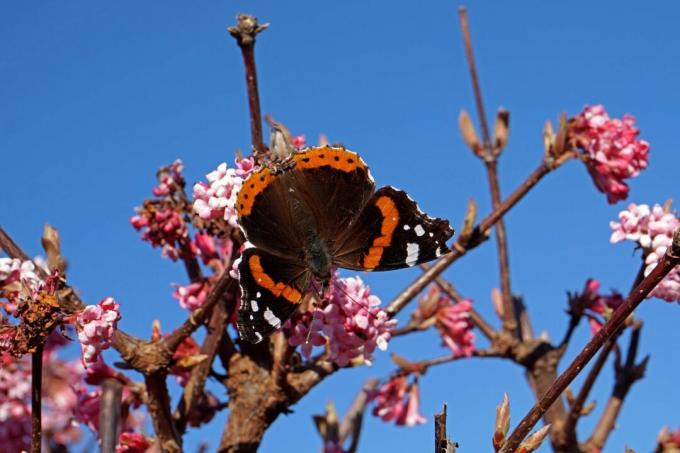
Multiply winter snowball
Top cuttings are suitable for a varietal propagation of the winter snowball in summer. These can be gained, for example, by pruning after flowering. The 10 - 15 cm long cuttings should be freed from the lower leaves and then planted halfway into pots with suitable potting soil. If you slightly injure the shoots at the cutting point beforehand and roll them in rooting powder, this increases the chances of success. Keep the pots regularly moist and place them in a bright spot out of direct sunlight. The ideal temperature is between 20 and 30 °C. Roots form quickly and the new plants can be transplanted into larger pots. Please note that the summer cuttings should not be planted out over the winter so that they do not freeze to death. Keep the winter snowball cuttings frost-free and bright in winter, but not too warm and not too humid. They will be planted out next spring.
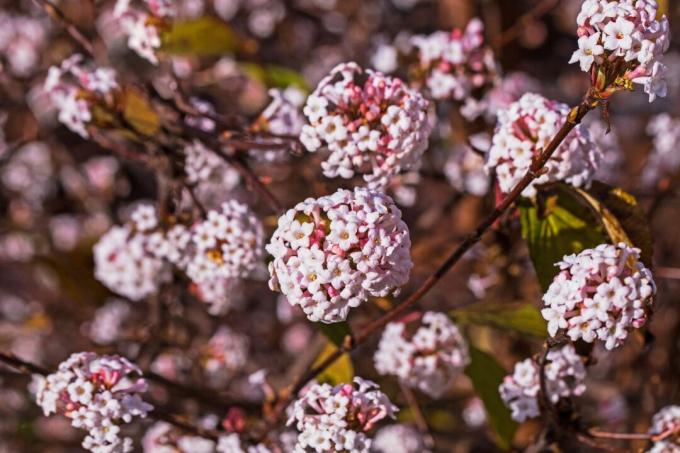
Alternatively, you can also use offshoots to propagate your winter snowball. In the field, the root suckers usually form by themselves. If these shoot out of the ground in spring, they can be separated from the mother plant and replanted. Make sure the new plants get enough water.
Properly hibernate
The winter snowball is a hardy ornamental shrub. Outdoors, the winter snowball can be protected from frost and cold by adding some bark mulch over the root ball. Occasionally, some flowers and buds freeze to death in icy temperatures, but this does not harm flowering. If the winter snowball is in a bucket, you must overwinter it in a cool, frost-free room or wrap it well in insulating material and cover it over the winter months.

Is the winter snowball poisonous?
The fruits, leaves and bark of the snowball are poisonous to humans. The toxicity is low, however, pets and children should not consume these parts of the winter snowball.
On mild, sunny winter days, the winter snowball seems to be a little winter miracle for wild bees, bumblebees and other pollinators in the winter landscape, which is otherwise sparsely blooming. However, due to the elongated flower shape and the low pollen and nectar levels, the winter snowball cannot be classified as particularly bee-friendly.
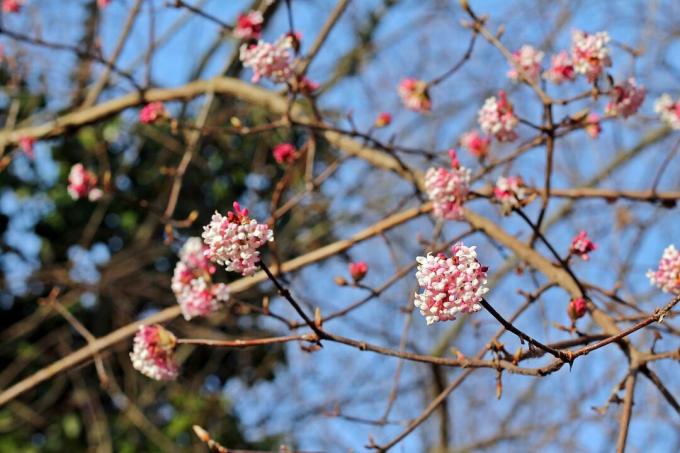
More decorative winter bloomers, which beautify the garden even in the cold season, we present to you in our article.
